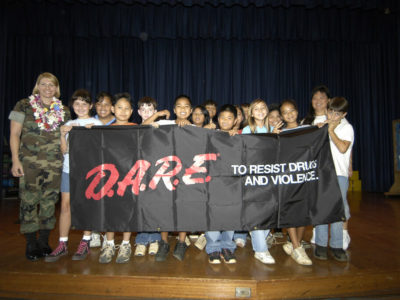Remember the D.A.R.E. program? Back in fifth grade, a police officer in a lion costume came to your classroom and told you that trying “angel dust” one time would kill you and that marijuana leads to teen pregnancy and suicide. They said the only way to safeguard yourself from all the druggies was to “Just Say No!” as loudly as possible to any and all drugs presented. That way you’d never be near drugs again because you’d be so insufferable that literally no one would invite you to another party.
That D.A.R.E. program.
Let’s see how it all turned out.
Pretty much terribly. D.A.R.E. (Drug Abuse Resistance Education) began in 1983 and has been a complete waste since its inception. Check it out; Project D.A.R.E., a study that spanned 1989 to 1999, tracked the progress of 1,000 sixth graders over 10 years. Though the DARE program claimed their goals were to lower the use of drugs and alcohol, Project D.A.R.E. showed that the program actually increased drug and alcohol consumption and may have lowered self-esteem in those that participated in the program.
You’d think that would be enough to kill funding, but D.A.R.E. turned out to be too hard to quit. D.A.R.E.’S structure provided a quick, easy way for politicians and schools to say they were taking a stand against crime, and no school wanted to be “that guy” who didn’t care about the kids. So on the D.A.R.E. program went, ill-conceived lessons passing from classroom to classroom like mono at a middle school party.
For all the public support D.A.R.E. got, it didn’t manage to totally escape criticism. The Connecticut General Assembly’s assistant director Judith Lohman wrote in a 2010 report that many academic and government evaluations showed even further how ineffective the DARE program truly was. Lohman summarizes the findings of approximately 30 evaluations in three bullets:
1. The program has some immediate positive effects on students’ knowledge of drugs, attitudes about drug use, social skills and attitudes toward the police.
2. These effects dissipate within one to two years of students’ participation in the program.
3. The program’s effect on drug use is either small or unidentifiable and, when identified, dissipates quickly.
She’s got a lot more to say here. A five-year study, similar to Project D.A.R.E., showed the same outcome. For years, DARE proved itself misguided and detrimental to students’ well being, not only in its application, but also in its results. Florida State University alumnus Chase Lurding commented on D.A.R.E.’s effect on him while a part of the program. “Superficially it did have the intended effect on me in that it made me more resistant to try drugs,” Lurding said. “But on a deeper level it made it inevitable that I would try drugs because it made me so curious to what that was. So eventually I had to try because, like I said, it was unlike anything else I had heard of.”
It may have taken decades, but the D.A.R.E. program finally revamped itself. They are now “keepin’ it REAL” (kiR), a program developed by Penn State in 2006 for high school students, adopted by D.A.R.E. in 2009.
By 2013, the new curriculum modified itself for fifth and sixth graders. In these new lessons, instructors speak for only about eight minutes, instead of the former 45, to leave more room for role playing to build communication and decision making skills. Reports say that students respond well to the hands on approach, acting out the Refuse, Explain, Avoid and Leave principles taught in the program (hence, REAL).
The National Institute on Drug Abuse (NIDA) has 16 principles that create effective “prevention programs.” This list includes concepts like number five, “Family-based prevention programs should enhance family bonding and relationships and include parenting skills; practice in developing, discussing, and enforcing family policies on substance abuse; and training in drug education and information (Ashery et al. 1998)” and number seven, “Prevention programs for elementary school children should target improving academic and social-emotional learning to address risk factors for drug abuse, such as early aggression, academic failure, and school dropout.”
All 16 of these principles are outlined on D.A.R.E.’s website. But the alarming part is that the exact curriculum that’s being taught, or even just a template of it, isn’t readily presented. To find a curriculum, I had to go on Penn State’s website but even then, it was hard to pin down exactly what goes on inside the classroom. The most detail I found mentioned all “enjoyable activities” to “illustrate the skills” of resistance strategies on which they never elaborate.
But, hey, they’re trying, right? It’s nice that D.A.R.E. has finally stopped being so obtuse about its own outdated, misguided attempts to indoctrinate a whole generation with false facts and scare tactics. It’s nice that they listen to research scientists instead of writing their own curriculum without any academic backing.
But that’s not enough. The social perception of drugs has changed so much since the 1980s and a lot of myths still persist.
Will kiR tell students about the medical benefits of marijuana? Will they mention how MDMA is used, successfully, to treat PTSD? How LSD has been used to aid in end of life therapy? Will they have presentations about how the “war on drugs” is used as an excuse to incarcerate minorities?
They want to “keep it REAL”
How’s that for keepin it real?



















